This April’s absolutely overloaded with a concerning amount of great graphic novels. These are my favorites.
To get these picks sent directly to your mailbox every month, sign up here for free.

Resonant
If you asked me my appetite for new zombie-apocalypse comics, I’d probably put it at somewhere between “none” and “why are you asking me that?” Resonant by DB Andry, Skylar Patridge, Jason Wordie and Deron Bennett works around the familiar trappings, and much like The Last of Us, finds a post-apocalypse approach that feels fresh, engaging, and full of characters you have to root for. The series was originally published for 10 issues between 2019-2021 via Vault Comics, and is back for a complete collection edition. If you missed the first go (like I did), it’s worth reconsidering.
Patridge and Wordie are a particularly effective art team, able to capture the quiet moments of a broken world as well as the chaos of what happens during invasive swarms. Andry accompanies them with a smart mixture of The Road inspired dread and child-heroes trying to survive the impossible. It’s scary, charming, and thrilling, all the things good post-apocalypse comics should be.
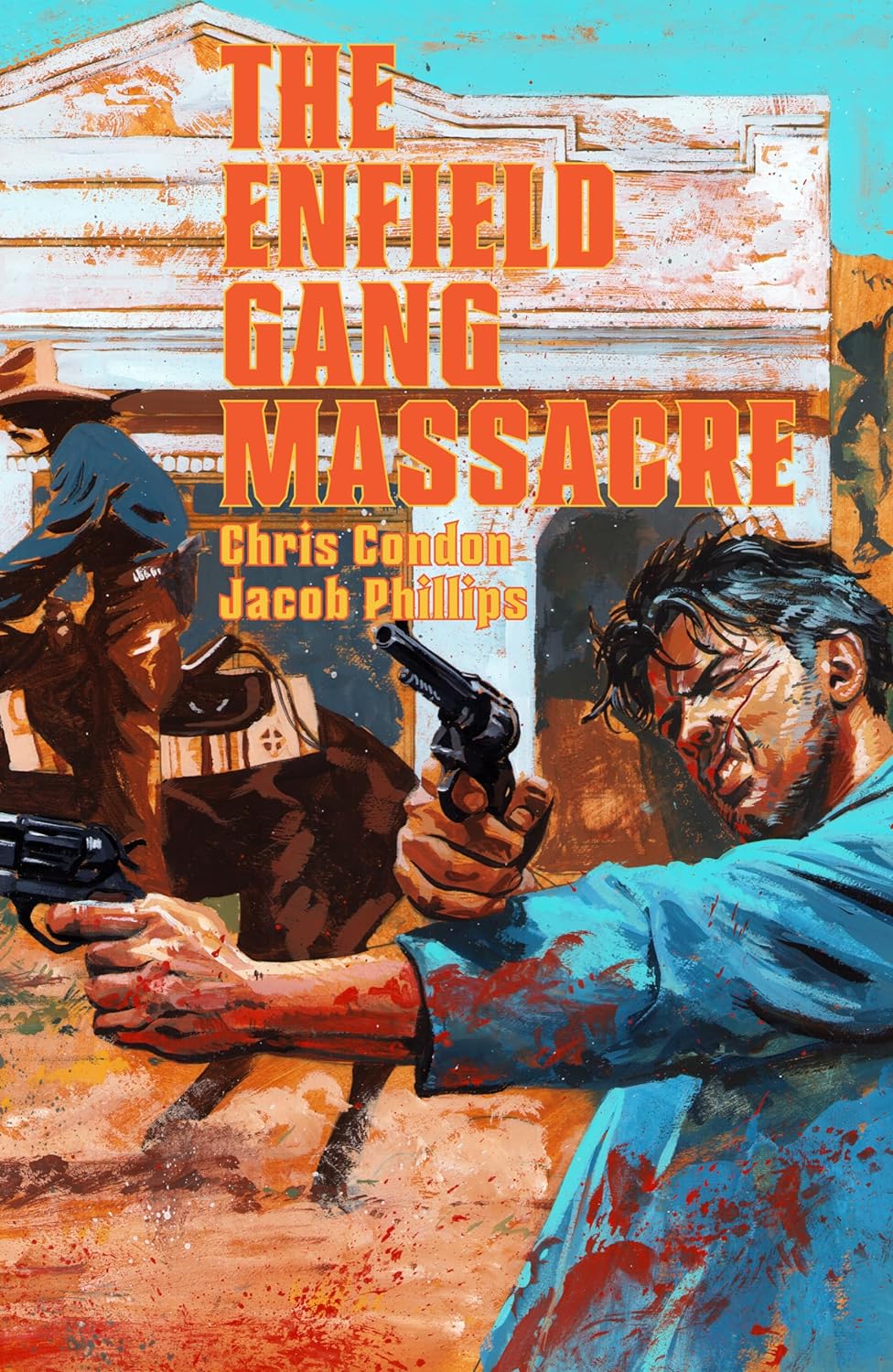
The Enfield Gang Massacre
Chris Condon and Jacob Phillips’s That Texas Blood is one of my favorite ongoing comics since its launch in mid-2020. The creative team is smart about taking breaks between installments to allow for quality (and presumably their own scheduling sanity), meaning each arc feels like a carefully calibrated document of small-town Texas crime. The latest “hiatus” took the form of a spinoff arc set entirely in the town’s past, documenting a somewhat mysterious massacre of outlaws hundreds of years ago. It’s a bold risk, and only loosely connected (at least on the surface) to the immediate action of That Texas Blood, but Condon and Phillips fully commit to the vision.
Support For Comic Book Herald:
Comic Book Herald is reader-supported. When you buy through links on our site, we may earn a qualifying affiliate commission.
Comic Book Herald’s reading orders and guides are also made possible by reader support on Patreon, and generous reader donations.
Any size contribution will help keep CBH alive and full of new comics guides and content. Support CBH on Patreon for exclusive rewards, or Donate here! Thank you for reading!
Under Phillips’s brush every setting sun makes me think, “Well maybe I would like to spend more time in Texas” (I wouldn’t!), and Condon’s dedication to backmatter ephemera highlights a unique hyper-obsessive loyalty to the worlds being created. It’s one thing to allude to a town’s past, it’s another to tell a story from hundreds of years ago, and then it’s an unprecedented third level to write the investigative journalism chronicling the discovery of truth about that story from inside the fictional universe. It’s the kind of “Alan Moore just straight up wrote an article on ornithology” level of craft that tells me I’m in the hands of storytellers who care so much. And that just innately makes me care too!
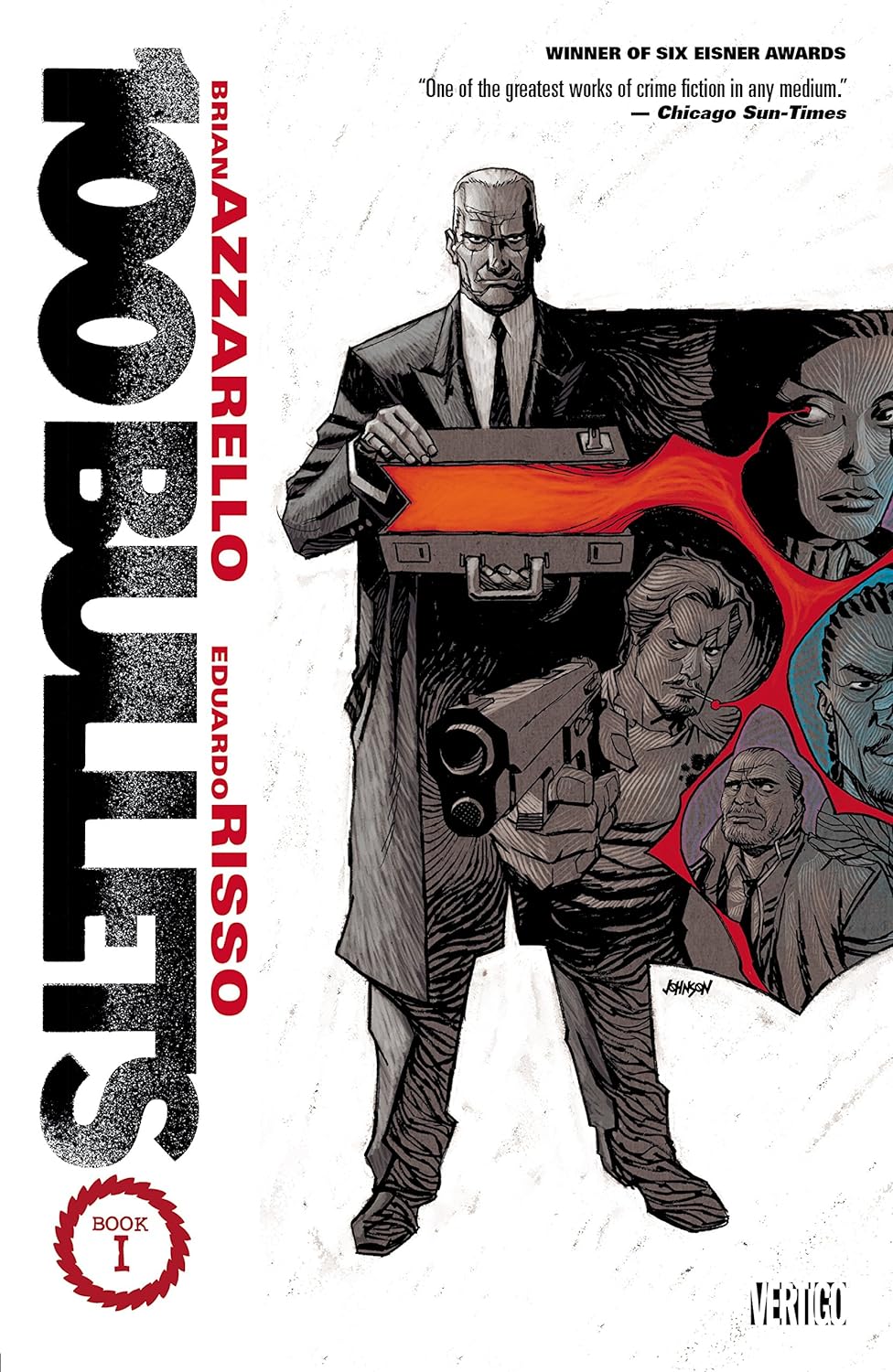
100 Bullets
Occasionally, my monthly scans of the League of Comic Geeks’ new trade releases lead to a… spot of confusion. For example, I might see that 100 Bullets Book 1 is receiving a compendium release and think, “Aha, my chance to dive headfirst into Brian Azzarello and Eduardo Risso’s crime opus!” But what I might not realize, dear reader, is that this “new” release is merely a variant cover on a collected edition older than all of my children combined.
So, no, there’s not really anything new here with 100 Bullets, but the good news is I finally sat down to read this 6-timer Eisner winner that ran via DC’s Vertigo from 2000 to 2009, and you’re not gonna believe this, but I like it a lot. I have a fuzzy memory of trying the first 3-5 issues way back when, and finding Risso’s fluid character work off-putting, and I’d like to borrow Doctor Doom’s time platform so I can properly flog myself for this horrible opinion. Risso is a marvel throughout 100 Bullets, mastering shadow like he’s Gene Colan or Mike Mignola, and although I can nitpick that too many of the Minutemen look kinda the same (which is only a problem insofar as I had a hard time distinguishing major players even 20+ issues in), that’s far overshadowed by brilliant pacing, angles and dramatic perspective.
At the time of this writing, I’m still finalizing my way through 100 Bullets Book 2 (up to issue #36), but the pairing of Azzarello and Risso is a great one, enough that I was very excited to dive into their more recent 28 issue Image work, Moonshine. Ideally, I’d fall hard enough for 100 Bullets that I could rank it as my 100th favorite comic of all time, but that seems like a tall order. Nonetheless, can it make the cut off for the published top 500? I fully think so, even though I’ve heard rumblings the back half doesn’t match the front!
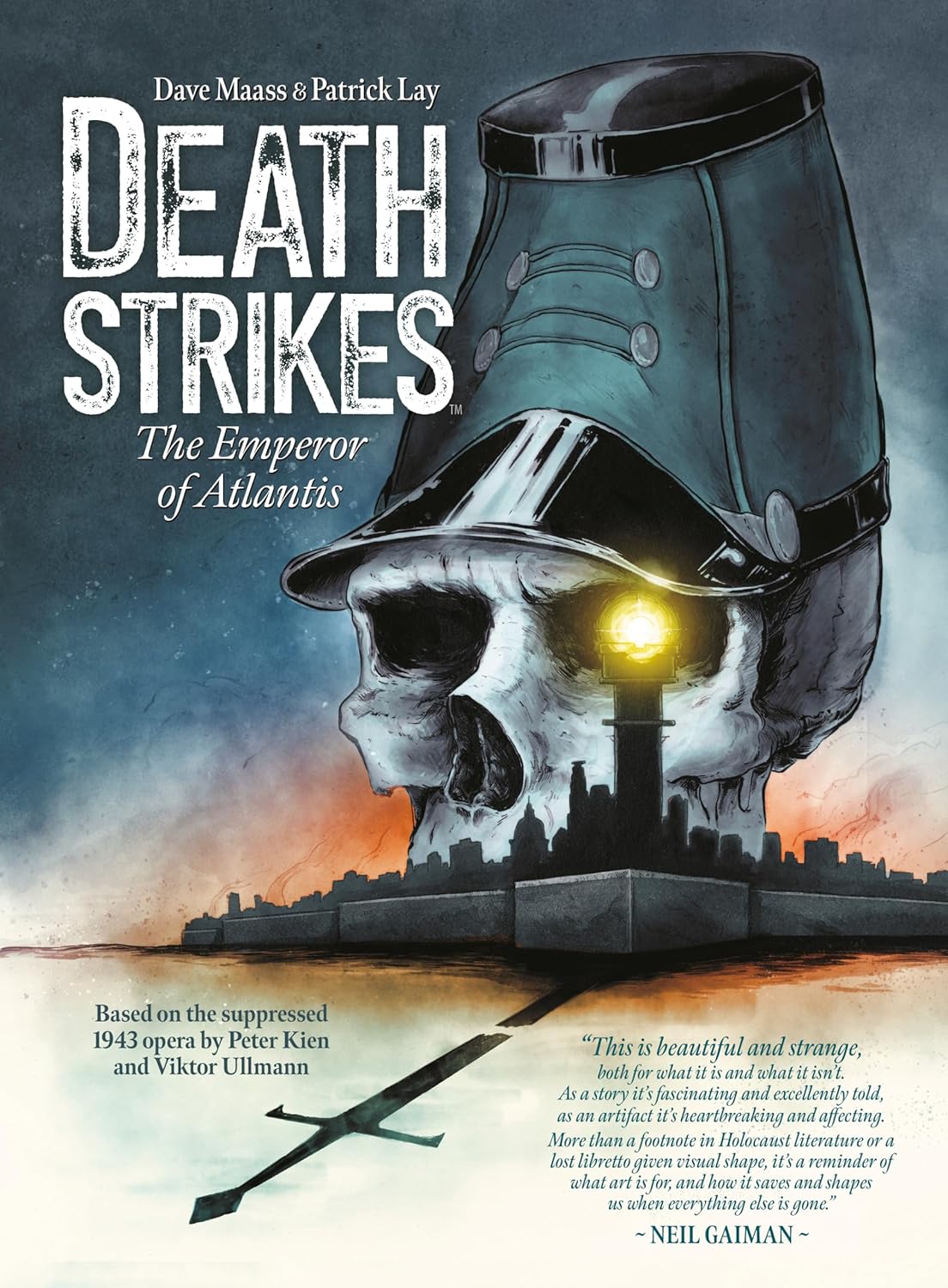
Death Strikes: The Emperor of Atlantis
Purely based on graphic novel title and publication by Dark Horse, you’d be forgiven for assuming Death Strikes: The Emperor of Atlantis is a well-worn genre thriller looking to expand upon the sandy shores of Aquaman and Namor. Cursory inspection reveals it’s anything but, though, as Dave Maass and Patrick Lay are actually adapting a suppressed 1943 opera by Jewish artists created inside a Nazi Germany concentration camp. The history alone, and the miracle of any retained art surviving the Holocaust is worth the price of admission. The comic looks to adapt Der Kaiser von Atlantis, created by Peter Kien and Viktor Ullman from within the Terezin concentration camp, and seeks to share how “beauty and humor can be found even in the face of doom.”
A work like this is in danger of flatlining at curious historical project, but Maass and Lay modernize and elevate the opera for comics with tremendous, care, relevance and precision. Death Strikes is funny, at times like Joseph Heller’s Catch-22 (a personal favorite), and the ink-washed grays are gorgeous. You’ll want to read the historical analysis that bookends the comic, but readers could pick this up without any of that context and simply enjoy a parodic dig into the rise of fascism and the endless ills of war. This is genuinely special work from Maass and Lay, living up to the weight of adapting something created in such historically harrowing circumstances.
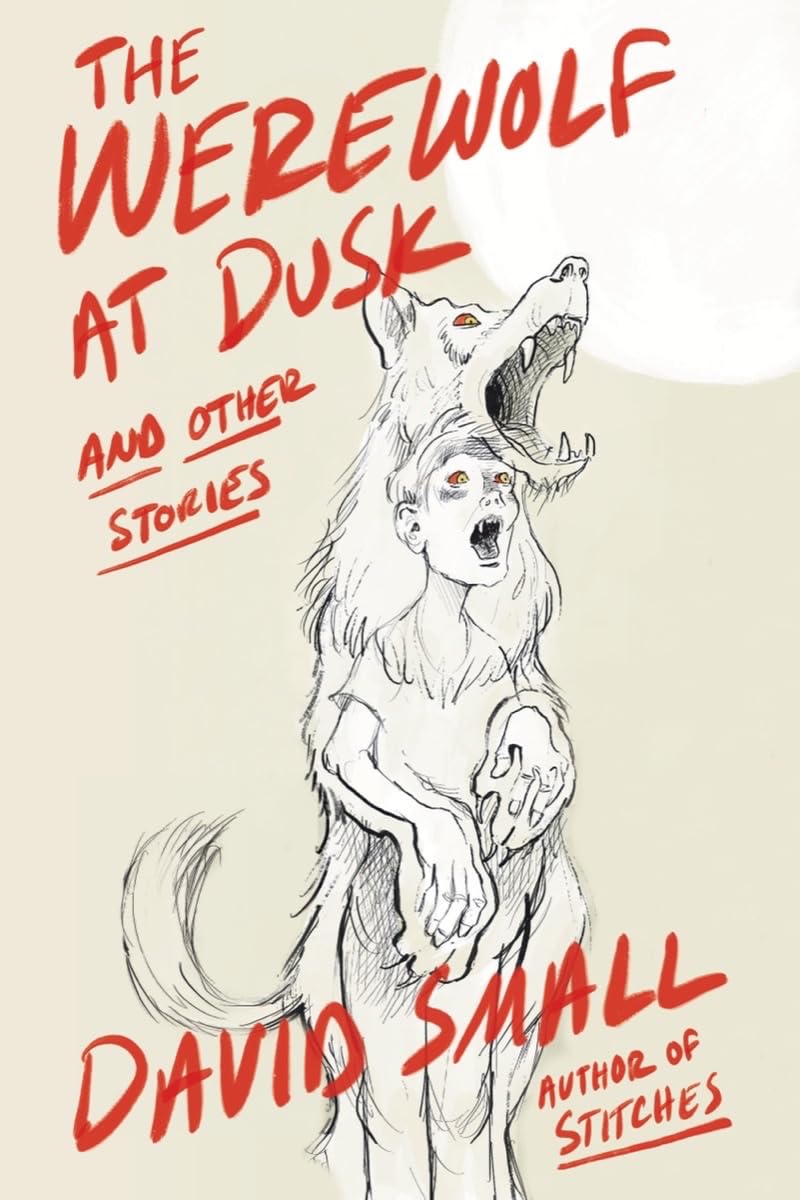
The Werewolf at Dusk: And Other Stories
I talk about this a lot, but I’m endlessly tantalized by how much I don’t know about comics. I feel like I have a pretty good grasp on the major celebrated works of the 2010’s, but then here’s David Small, an artist I’ve never encountered before, with a graphic memoir, Stitches, so beloved it’s blurbed by R. Crumb and Stan Lee! Small’s so good he has Gene Luen Yang saying, “David Small is among the most masterful storytellers alive today.” I don’t know anything about anything. It’s great!
Small’s latest is a series of three short stories: The Werewolf at Dusk, A Walk in the Old City (the only of the three also written by Small), and The Tiger in Vogue. The works are compulsively readable, and compulsively inspiring, with Small working in an almost child-like partially sketched pen that makes me want to stop what I’m doing and draw my own aging werewolves. The difference of course is that Small knows what he’s doing with the absence of a line, or a detail-less grocery aisle, allowing character expression and a laconic narrative do the heavy lifting. For my money, The Tiger in Vogue is the standout, a surreal adaptation of Jean Ferry’s story about the rise of fascism in early 1920’s Germany, as told by a man attending a musical with a woman and a literal tiger as the star attractions. It taps into the same themes as the previous works – aging as the world changes and shifts the ground beneath your feet – but while also capturing the madness inducing fear that comes from watching a small mustached man controlling a crowd in ways only you seem to fully understand.
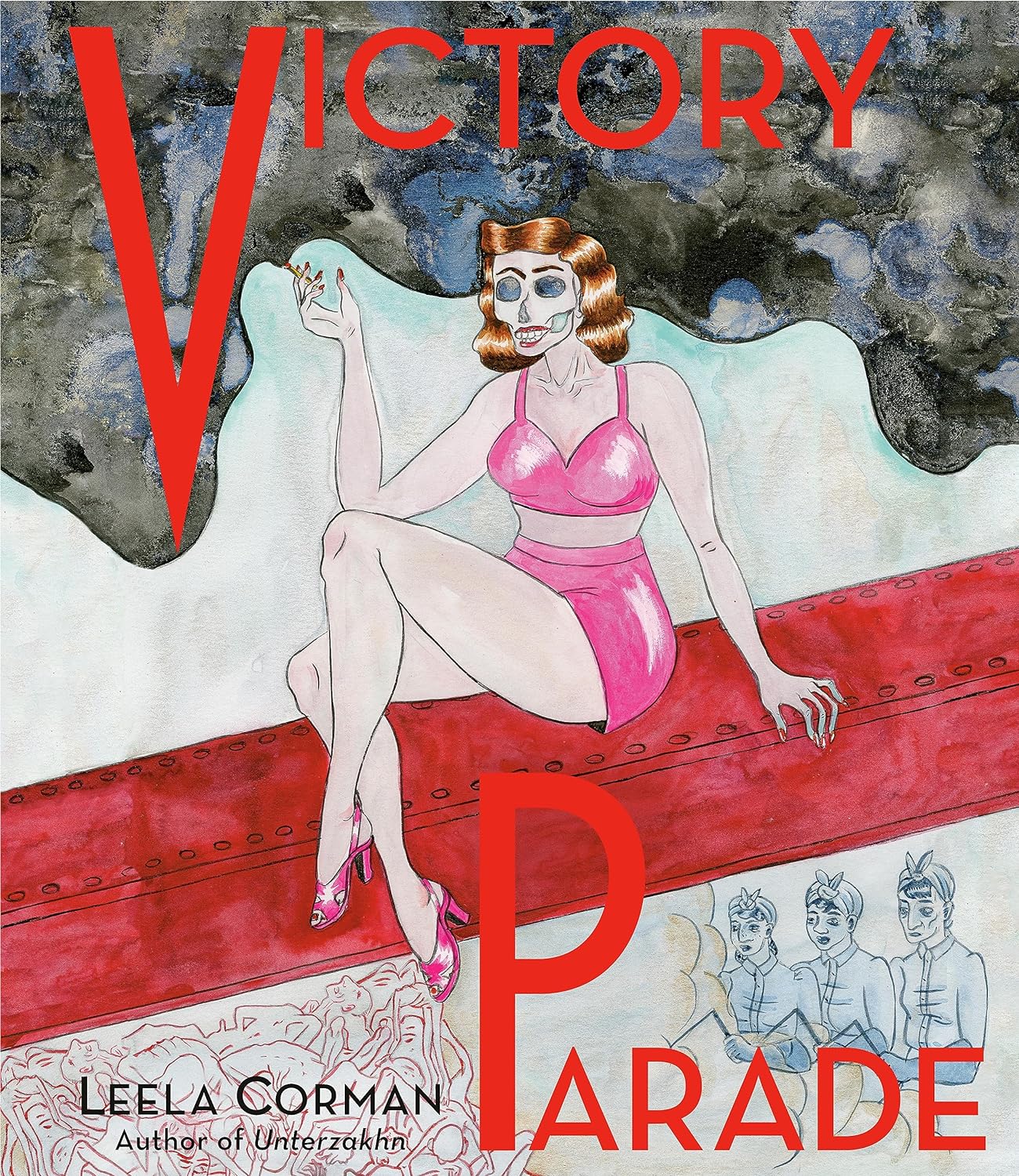
Victory Parade
When Leela Corman sets out to make a graphic novel, she makes a graphic novel built to win awards. The early 2010’s Unterzakhn is a tremendous work, following twin sisters navigating New York’s Lower East side as Jewish immigrants circa 1910. Corman wields an innate ability to transform history into an emotionally resonant present, with casts of fierce women encompassing the full spectrums of humor, heart, and heart of fully realized lives. Victory Parade walks a similar emotional path, following the lives of Brooklyn women navigating World War II in America as German-Jewish refugees.
In Victory Parade, Corman eschews the black-and-white thick inks for a lush and times surreal palette of softly melting watercolors. The oversized Pantheon Graphic Library hardcover allows for a wider canvas, which Corman uses to full effect, particularly during hallucinogenic dream sequences full of dissected anatomy depicting subconscious trauma in the lives of these characters. Even so, the ‘realism’ of the history is only augmented through fever dreams and flashbacks, whether it’s memories of pre-Nazi Germany or Sam’s nightmares of seeing the post-liberation Buchenwald concentration camp. Corman’s quite carefully considered in depicting the rampant blend of misogyny and xenophobia of the era as well, even down to lettering that snakes around a lead character’s neck like a noose of jeers.
Corman’s ambitions – in tone, pacing, character focus – all seem larger than the inevitable Unterzakhn comparisons, and not always to her benefit. Ruth’s journey into women’s professional wrestling of the era could likely have been a whole graphic novel of its own, but within Victory Parade, it’s a bit clouded in all the moving parts. Nonetheless, this is fascinating work from an incredible talent, and well worth seeing in print.
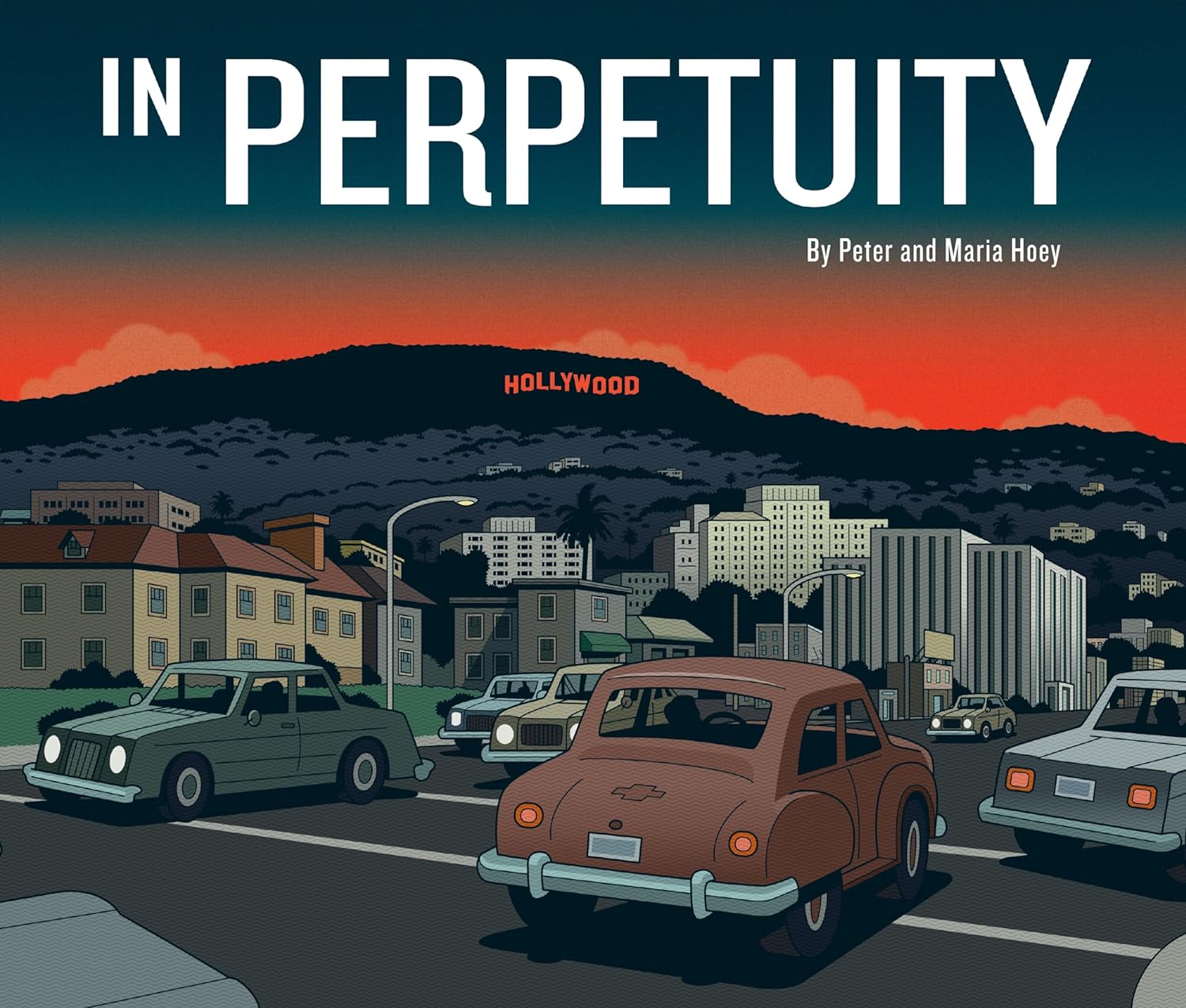
In Perpetuity
Maria and Peter Hoey’s In Perpetuity, out now from Top Shelf Productions, is a brilliant exercise in comic-making restraint. Stylistically like Chris Ware’s slice-of-life decompression meets the staccato movements of Robot Chicken figures, In Perpetuity is told primarily through stilted, matter-of-fact third-person narration. “Jim walked over to his car.” “He took the bus to make it more believable.” “Kimberly continued on and did not look back.” The repetition and simplicity captures the mundanity of In Perpetuity‘s Afterlife, a vision not of heaven nor hell, but instead one of tedium and limited pleasures. The lead character works as a gas station attendant, with days largely broken apart by crossword puzzles and cigarettes, until an old acquaintance from life pulls him into a criminal enterprise contacting the living from the A.L.
As In Perpetuity develops, its reimagining of the Greek afterlife mixes in noirish mystery, conspiracy, and ultimately a confrontation with the ruler of the A.L, Hades. It’s a masterful mixture of genre, both compelling as narrative and contemplative of the joys we take for granted of in this life.
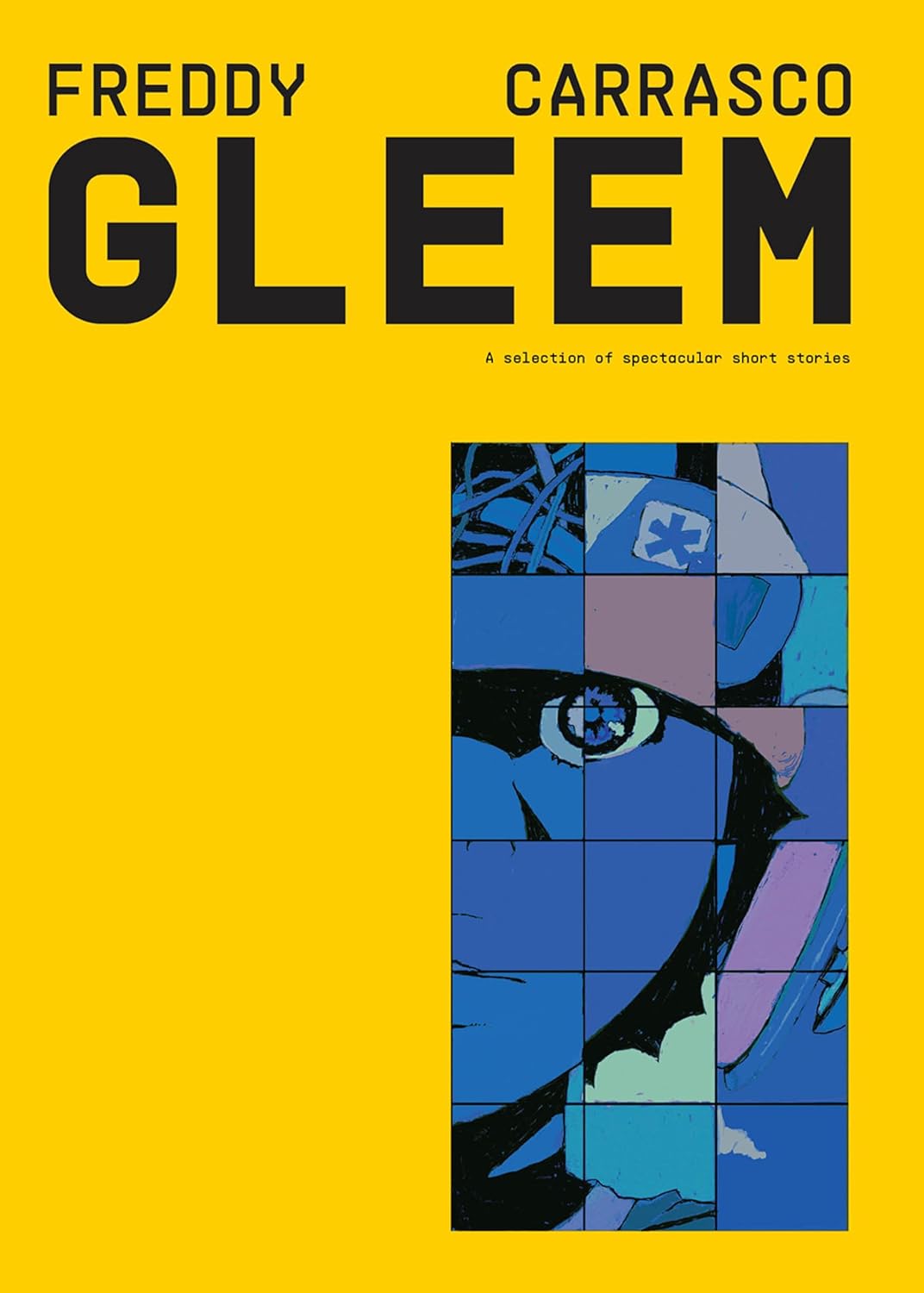
Gleem
Originally published in 2019, Freddy Carrasco’s “selection of spectacular short stories” is so good Drawn & Quarterly picked up the out-of-print work for a new edition this year. I’m very glad they did, as Carrasco’s fully-realized sci-fi worlds walk an incredible blend between Taiyo Matsumoto’s Tekkon Kinkreet and the cosmos-shattering spiritualism of Jim Starlin reincarnated in the pen of Ronin-era Frank Miller. Gleem is composed of three distinct stories, one a bored kid’s accidental spiritual journey at a future megachurch, another what happens when bored kids add a defective robot AI to their crew, and a final that I can best describe as what it’s like for bored kids to do future-drugs at the coolest rave I’ll never get invited to.
Carrasco’s cartooning is confident and inspiring, the kind that often invites you to make your own comics even as its displaying a control of the page that can only come from immense creative experience. In his book blurb, Michael DeForge writes, “Nobody’s doing space and time the way Freddy Carrasco does space and time,” and it’s hard to argue otherwise. Sequences where a teen at church loses himself in a swirling fever dream made up of lust and a fish asking him if he’s paid his taxes are, uh, hard to pull off! Within Gleem‘s walls it all makes a delirious amount of sense.
From here on out, I’ll be reading anything Carrasco releases, no questions asked.
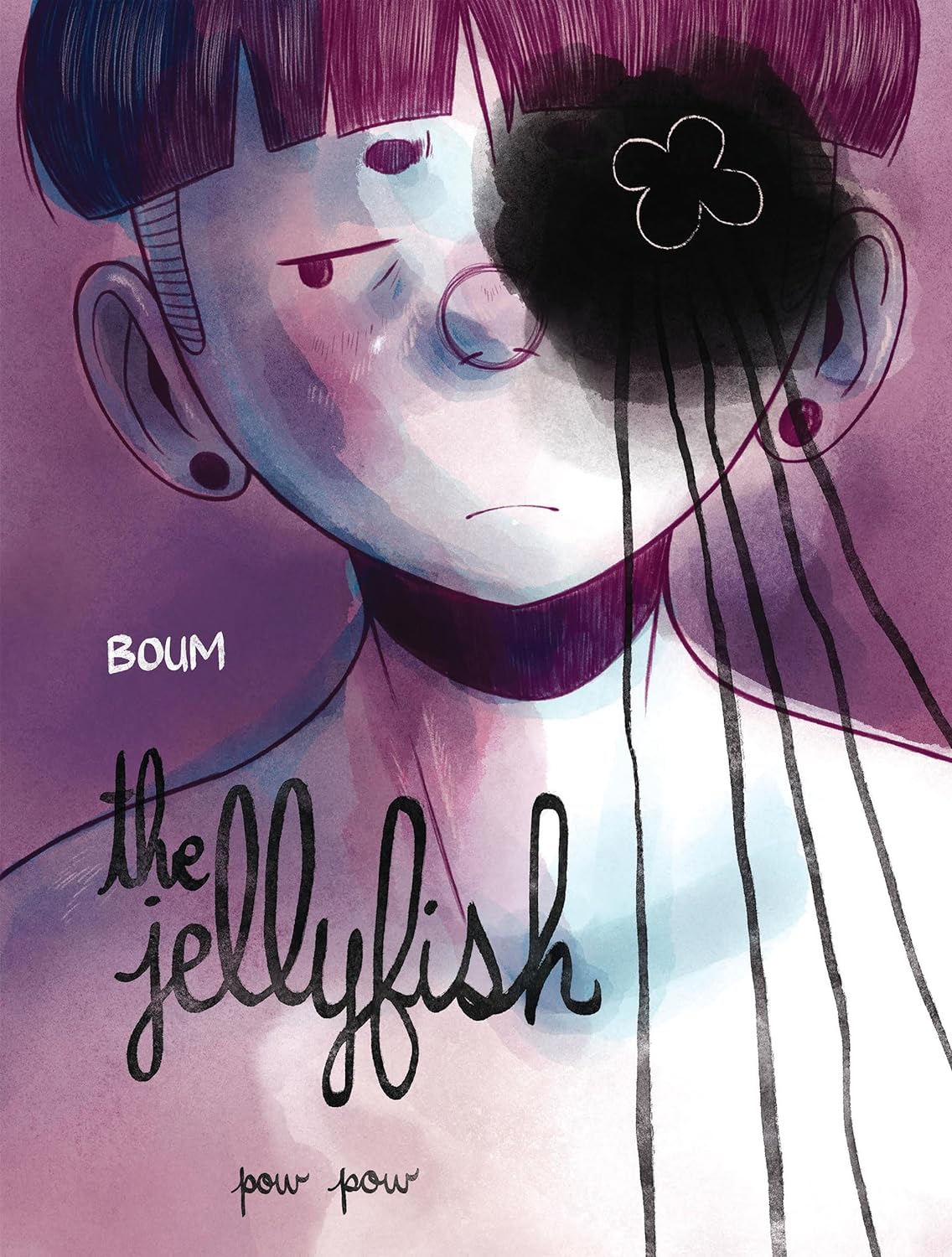
The Jellyfish
One of my favorite surprise graphic novels of the year, simply due to my lack of familiarity with the artist Boum and Pow Pow Press. The Jellyfish is a gorgeous, touching, queer work, and one of the better explorations of what it feels like when doctors can’t tell you what the hell is wrong! The premise is that Odette, a young Canadian woman, develops a unique condition where she has a… Jellyfish… in her eye. This condition is stated as both unique and completely matter-of-fact, as Boum depicts literal floating black spots of jellyfish circling around Odette, growing in number as Odette’s condition worsens. Doctor visits confirm Odette does in fact have Jellyfish in her eyes, but aren’t able to offer much by of solution, apart from more doctor visits and prescriptions that maybe might help but who really knows (I’ve been there so hard!). In the midst of all this, Odette falls for another young woman experiencing the traumatizing abuses of her father/boss. It’s a sweet, touching romance in the face of impending health failure and resonates deeply.
It’s a hyper-specific thing, too, but I love how The Jellyfish seamlessly incorporates a sick mid-aughts indie dance rock playlist of songs by groups like Gorillaz and The Rapture. Obviously comics can’t capture sound, but I do find that reference points are an effective way to present scene, tone and time period. This is especially true when all the songs are tracks I know – I danced to Gorillaz in 2006 too! – but plenty of times it’s led to discovery (I’m thinking here of when I interviewed Stephen Franck and discovered “Honky Tonk Hardwood Floor” in his L.A. country bar noir). Again, the end result is a work of art that feels intensely lived-in, and intensely relatable, only adding to the ways it completely pulled me into this world of all-consuming Jelly.
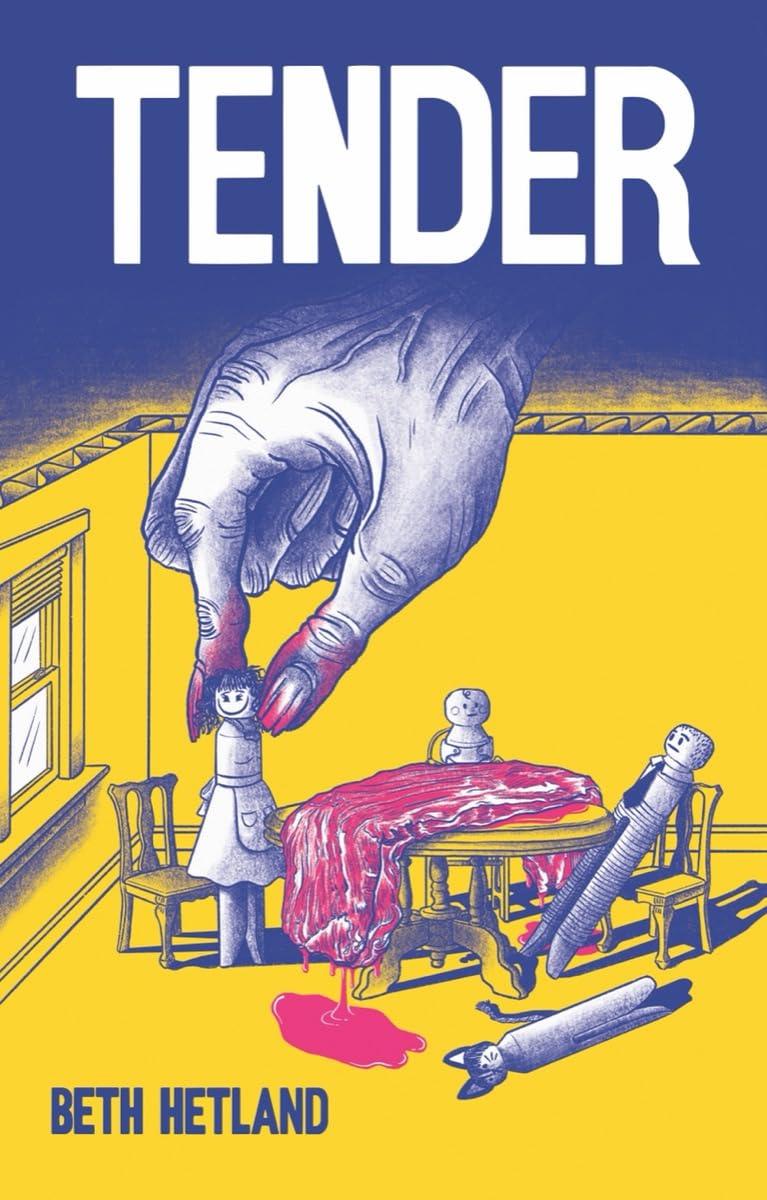
Tender
Beth Hetland’s graphic novel debut from Fantagraphics looked me directly in the eyes, crawled under the lids, and rooted around in the slimiest corners of my brain all night. If that’s a little too gross, Tender might not be for you! This astounding work combines modern social pressures, body horror, fever dreams, expectations, grief, eating cats, and trauma like nothing I’ve ever read. Ok, fine, that’s a pretty specific combination, but hot damn if it doesn’t work under Hetland’s carefully constructed nightmare.
Tender effortlessly oscillates between the familiar patterns of adulthood (first comes love, then comes marriage, then a baby in a baby carriage!) and a creeping, sinister darkness under the current that grows to a nauseating critical mass where there’s no hiding it. Hetland isn’t the first artist to try and turn suburbia into horror, but the blend of yearning for a perfect family you can brag about onto Instagram alongside exaggerated truly grotesque scenes of self-mutilation is a rare kind of resonant. Hetland shows a confident grasp of restraint, setting scenes of suburbia in ink-washed grays and blues, but unleashing the destructive forces of angry reds and yellows during 12+panel pages of psycho-kinetic terror. I couldn’t put Tender down, even knowing it would wreak havoc on my dreams, and I’ll be reading anything from Hetland in the future.
Leave a Reply